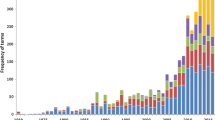Abstract
Google Scholar (GS) has progressively emerged as a tool which “provides a simple way to broadly search for scholarly literature across many disciplines and sources.” As a free tool that provides citation metrics, GS has opened the academic word to a much larger audience, according to an open information philosophy. GS’ profiles are largely used not only to have a quick look at the authors and their works but, more and more often, as a “de facto” metric to quickly evaluate the research impact. This process looks unstoppable and discussing about its fairness, advantages and disadvantages, as well as about social implications is out of the scope of this paper. We rather prefer to (1) briefly discuss the changes and the innovation that GS has introduced and to (2) propose possible improvements for analysis on academic citations. Our methods are aimed at considering a GS profile in its proper context, providing a social perspective on academic citations: Although maintaining a fundamentally quantitative focus, novel approaches, based on complex network analysis, distinguish between a research impact on the authors’ research network and a more general impact on the scientific community.




Similar content being viewed by others
References
Acm digital library. http://dl.acm.org. Accessed 21 Oct 2015
Core—conference portal. http://portal.core.edu.au/conf-ranks/. Accessed 01 Feb 2017
Googlescholar. http://scholar.google.com. Accessed 21 Oct 2015
Ieeexplore. http://ieeexplore.ieee.org. Accessed 21 Oct 2015
Journal Citation Report (JCR). http://about.jcr.incites.thomsonreuters.com. Accessed 01 Feb 2017
Researchgate. https://www.researchgate.net. Accessed 21 Oct 2015
Scopus. https://www.scopus.com. Accessed 21 Oct 2015
Semantic Scholar Project. https://www.semanticscholar.org/. Accessed 01 Feb 2017
Thomson ISI Web of Science. http://thomsonreuters.com/en/products-services/scholarly-scientific-research/scholarly-search-and-discovery/web-of-science.html. Accessed 21 Oct 2015
Aggarwal, C.C., Wang, H., et al.: Managing and Mining Graph Data, vol. 40. Springer, Berlin (2010)
Antelman, K.: Do open-access articles have a greater research impact? Coll. Res. Libr. 65(5), 372–382 (2004)
Bakkalbasi, N., Bauer, K., Glover, J., Wang, L.: Three options for citation tracking: Google scholar, scopus and web of science. Biomed. Digit. Libr. 3(1), 7 (2006)
Balduzzi, M., Platzer, C., Holz, T., Kirda, E., Balzarotti, D., Kruegel, C.: Abusing social networks for automated user profiling. In: Jha, S., Sommer, R., Kreibich, C. (eds.) Recent Advances in Intrusion Detection, pp. 422–441. Springer, Berlin (2010)
Banks, M.: Connections between open access publishing and access to gray literature. J. Med. Libr. Assoc. 92(2), 164 (2004)
Bar-Ilan, J.: Which h-index? A comparison of wos, Scopus and Google Scholar. Scientometrics 74(2), 257–271 (2008)
Barabâsi, A.-L., Jeong, H., Néda, Z., Ravasz, E., Schubert, A., Vicsek, T.: Evolution of the social network of scientific collaborations. Phys. A Stat. Mech. Appl. 311(3), 590–614 (2002)
Ceri, S., Bozzon, A., Brambilla, M., Della Valle, E., Fraternali, P., Quarteroni, S.: Web information retrieval. Data-centric systems and applications, Springer, Berlin (2013)
Cook, T.D.: Emergent principles for the design, implementation, and analysis of cluster-based experiments in social science. Ann. Am. Acad. Political Soc. Sci. 599(1), 176–198 (2005)
Glänzel, W., Moed, H.F.: Journal impact measures in bibliometric research. Scientometrics 53(2), 171–193 (2002)
Golafshani, N.: Understanding reliability and validity in qualitative research. Qual. Rep. 8(4), 597–606 (2003)
Harzing, A.-W.: Google Scholar-A New Data Source for Citation Analysis. University of Melbourne, Parkville (2008)
Hirsch, J.E.: An index to quantify an individual’s scientific research output. Proc. Natl. Acad. Sci. USA 102(46), 16569–16572 (2005)
Holbrook, J.B., Barr, K.R., Brown, K.W.: Research impact: we need negative metrics too. Nature 497(7450), 439–439 (2013)
Holzinger, A.: Universal access to technology-enhanced learning. Univ. Access Inf. Soc. 7(4), 195–197 (2008)
Jacsó, P.: Google scholar: the pros and the cons. Online Inf. Rev. 29(2), 208–214 (2005)
Khambatti, M., Ryu, K.D., Dasgupta, P.: Structuring peer-to-peer networks using interest-based communities. In: Aberer, K., Koubarakis, M., Kalogeraki, V. (eds.) Databases, Information Systems, and Peer-to-Peer Computing, pp. 48–63. Springer, Berlin (2004)
McAfee, A., Brynjolfsson, E., Davenport, T.H., Patil, D.J., Barton, D.: Big data. The management revolution. Harvard Bus Rev 90(10), 61–67 (2012)
Meho, L.I., Yang, K.: Impact of data sources on citation counts and rankings of lis faculty: web of science versus scopus and google scholar. J. Am. Soc. Inf. Sci. Technol. 58(13), 2105–2125 (2007)
Murugesan, S.: Understanding web 2.0. IT Prof. 9(4), 34–41 (2007)
Neuman, W.L.: Social Research Methods: Quantitative and Qualitative Approaches, vol. 13. Allyn and Bacon, Boston (2005)
O’reilly, T.: What is web 2.0: design patterns and business models for the next generation of software. Commun. Strateg. 65(1), 17 (2007)
Pileggi, S.F., Fernandez-Llatas, C., Traver, V.: When the social meets the semantic: social semantic web or web 2.5. Future Internet 4(3), 852–864 (2012)
Sanchez, C.A., Wiley, J., Goldman, S.R.: Teaching students to evaluate source reliability during internet research tasks. In: Proceedings of the 7th International Conference on Learning Sciences, pp. 662–666. International Society of the Learning Sciences (2006)
Serenko, A., Bontis, N.: Meta-review of knowledge management and intellectual capital literature: citation impact and research productivity rankings. Knowl. Process Manag. 11(3), 185–198 (2004)
Skyrms, B., Pemantle, R.: A dynamic model of social network formation. In: Gross, T., Sayama, H. (eds.) Adaptive Networks, pp. 231–251. Springer, Berlin (2009)
Stephanidis, C., Savidis, A.: Universal access in the information society: methods, tools, and interaction technologies. Univ. Access Inf. Soc. 1(1), 40–55 (2001)
Ullrich, C., Borau, K., Luo, H., Tan, X., Shen, L., Shen, R.: Why web 2.0 is good for learning and for research: principles and prototypes. In: Proceedings of the 17th International Conference on World Wide Web, pp. 705–714. ACM (2008)
Xiang, R., Neville, J., Rogati, M.: Modeling relationship strength in online social networks. In: Proceedings of the 19th International Conference on World wide web, pp. 981–990. ACM (2010)
Acknowledgements
We would like to thank the survey participants who have provided insight and expertise that greatly assisted this research.
Author information
Authors and Affiliations
Corresponding author
Rights and permissions
About this article
Cite this article
Pileggi, S.F. Looking deeper into academic citations through network analysis: popularity, influence and impact. Univ Access Inf Soc 17, 541–548 (2018). https://doi.org/10.1007/s10209-017-0565-5
Published:
Issue Date:
DOI: https://doi.org/10.1007/s10209-017-0565-5




